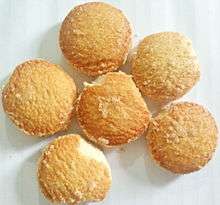Nankhatai
 | |
| Alternative names | Kulcha-e-Khataye |
|---|---|
| Type | Shortbread |
| Place of origin | Surat |
| Region or state | Indian subcontinent |
| Associated national cuisine | India, Bangladesh, Pakistan |
| Main ingredients | Wheat flour, Rice flour, Butter, Powdered Sugar, Milk/Yogurt, Salt, Honey, Baking Powder |
Nankhatai (Hindi: नानख़टाई Urdu: نان خطائی) are shortbread biscuits, originating from the Indian subcontinent, popular in India and Pakistan.[1] The word Nankhatai is derived from Persian word Naan meaning bread and "Khatai" from an Afghan word meaning Biscuit.[2][3] In Afghanistan and Northeast Iran, these biscuits are called Kulcha-e-Khataye. Kulcha is a type of bread similar to Naan.[4]
History
Nankhatai is believed to have originated in Surat in the 16th century, the time when Dutch and Indians were the important spice traders. A Dutch couple set up a bakery in Surat to meet the needs of local Dutch residents. When the Dutch left India, they handed over the bakery to an Iranian.[5] The bakery biscuits were disliked by the locals.[6] To save his business he started selling dried bread at low prices. It became so popular that he started drying the bread before selling it. With time, his experimentation with bread ultimately gave birth to Nankhatai.[2][3]
See also
References
- ↑ "Bakeri launches Nankhatai with packaging that makes waves". Aurora. Archived from the original on 2015-04-30.
- 1 2 "Nankhatai - The Dying Indian Biskoot - NDTV Food". Food.ndtv.com.
- 1 2 "Nankhatai Cookies With Rose And Chai Spices Recipe". Food.com. 17 February 2015.
- ↑ "What is the difference between Kulcha and Naan". Chefinyou.com.
- ↑ "About Nankhatai". Ifood.tv. Retrieved 17 August 2018.
- ↑ "Treks and Treats". Treksandtreats.com.